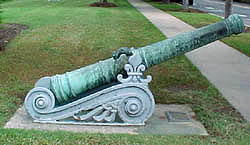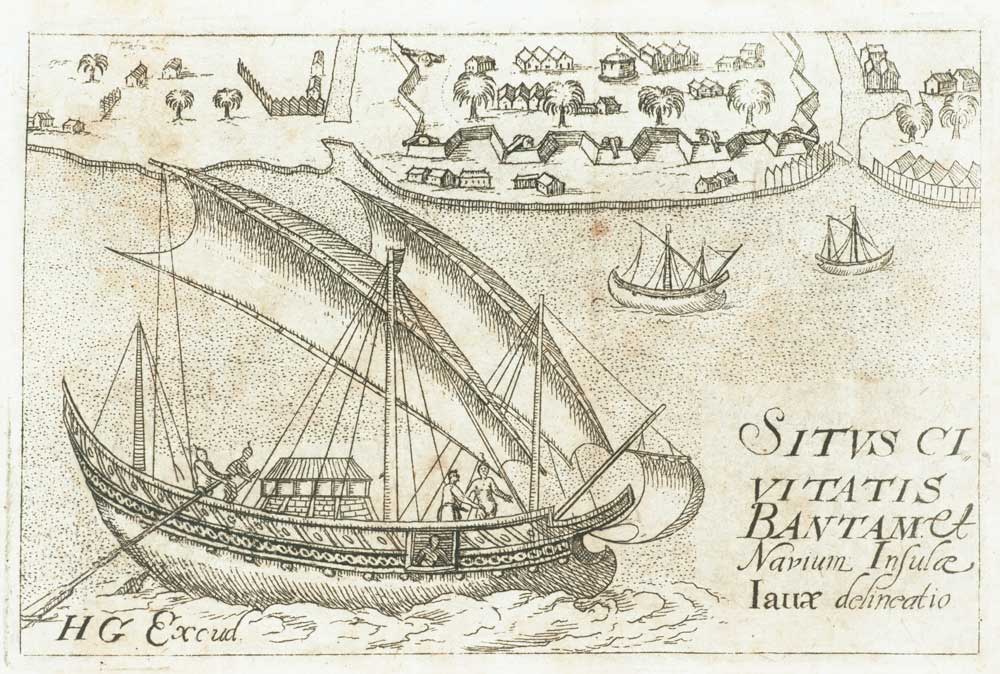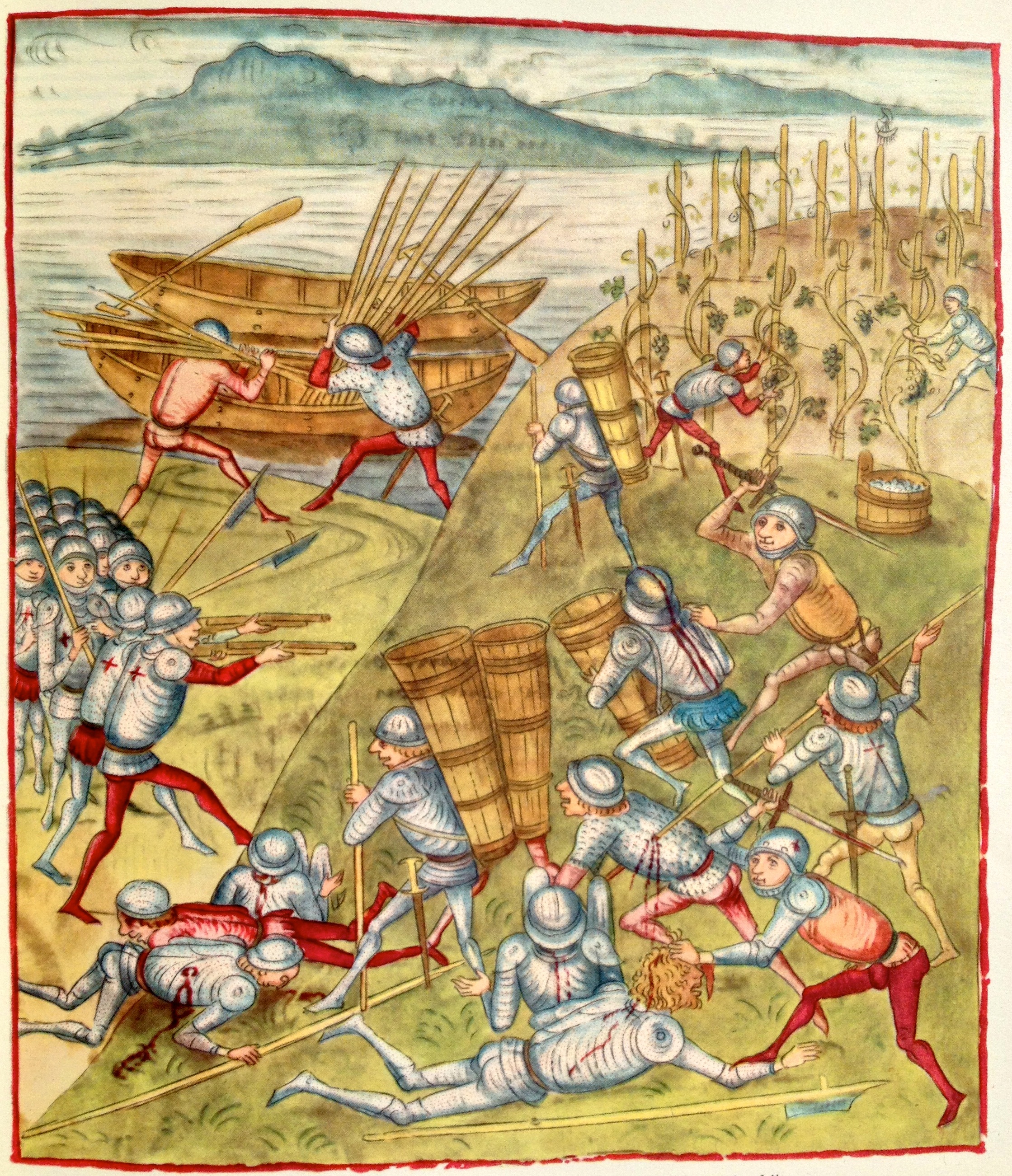|
Peter Pomegranate
''Peter Pomegranate'' was a warship of the English Tudor navy, built in 1510. Her name most likely was in honour of Saint Peter and the badge of Queen Catherine of Aragon, a pomegranate. History She had a tonnage of 400 or 450 when first built. In 1536 she was rebuilt and enlarged to a tonnage of 600. At that date the name was shortened to ''Peter'' (Catherine had fallen out of grace; she died in 1536). The ship's fate is not recorded, but she was last mentioned in records in 1558. ''Peter Pomegranate'' was a contemporary of the ''Mary Rose'' and, commanded by John Clere (died 1557), John Clere, took part in the Battle of the Solent on 19 July 1545 when the Mary Rose was lost. Named in full in the roster as "Peter Pomgarnarde", she joined Edward Clinton's invasion fleet against Scotland in August 1547. According to an Inventory of Henry VIII of England, inventory of 1547, the rebuilt ''Peter'' had 185 sailors, 185 soldiers, and 30 gunners. Her armaments included; 2 brass dem ... [...More Info...] [...Related Items...] OR: [Wikipedia] [Google] [Baidu] |
Anthony Roll
The Anthony Roll is a written record of ships of the English Tudor navy of the 1540s, named after its creator, Anthony Anthony. It originally consisted of three rolls of vellum, depicting 58 naval vessels along with information on their size, crew, armament, and basic equipment. The rolls were presented to King Henry VIII in 1546, and were kept in the royal library. In 1680 King Charles II gave two of the rolls to Samuel Pepys, who had them cut up and bound as a single volume book, which is now in the Pepys Library at Magdalene College, Cambridge. The third roll remained in the royal collection until it was given by King William IV to his daughter Lady Mary Fox, who sold it to the British Museum in 1858; it is now owned by the British Library. The Anthony Roll is the only known fully illustrated inventory of ships of the English navy in the Tudor period. As the work of a successful state official in 16th-century England, the artistic value of the Anthony Roll has been descri ... [...More Info...] [...Related Items...] OR: [Wikipedia] [Google] [Baidu] |
Saker (cannon)
The saker was a medium cannon, slightly smaller than a culverin, developed during the early 16th century and often used by the English. It was named after the saker falcon, a large falconry bird native to the Middle East. A saker's barrel was approximately long, had a caliber, calibre of , and weighed approximately . It could fire List of cannon projectiles, round shot weighing approximately using of black powder. The shot was intended to bounce along the ground to cause as much damage as possible, the explosive shell (projectile), shell being rare before the 19th century. Tests performed in France during the 1950s show that a saker's range was over when fired at a 45-degree angle. Henry VIII of England, Henry VIII amassed a Inventory of Henry VIII of England, large arsenal of sakers in the early 16th century as he expanded the Royal Navy and came into conflict with France. Henry's foundries used so much bronze that there was a world shortage of tin. According to the inve ... [...More Info...] [...Related Items...] OR: [Wikipedia] [Google] [Baidu] |
Rough Wooing
The Rough Wooing (; December 1543 – March 1551), also known as the Eight Years' War, was part of the Anglo-Scottish Wars of the 16th century. Following the English Reformation, the break with the Catholic Church, England attacked Scotland, partly to break the Auld Alliance and prevent Scotland being used as a springboard for future invasion by Kingdom of France, France, partly to weaken Scotland, and partly to force the Scottish Parliament to confirm the existing marriage alliance between Mary, Queen of Scots (born 8 December 1542), and the English heir apparent Edward VI of England, Edward (born 12 October 1537), son of King Henry VIII, under the terms of the Treaty of Greenwich of July 1543. An invasion of France was also contemplated. Henry declared war to force the Scottish Parliament to agree to the planned marriage between Edward, who was six years old at the start of the war, and the infant queen, thereby creating a new alliance between Scotland and England. Upon Ed ... [...More Info...] [...Related Items...] OR: [Wikipedia] [Google] [Baidu] |
16th-century Ships
The 16th century began with the Julian calendar, Julian year 1501 (represented by the Roman numerals MDI) and ended with either the Julian or the Gregorian calendar, Gregorian year 1600 (MDC), depending on the reckoning used (the Gregorian calendar introduced a lapse of 10 days in October 1582). The Renaissance in Italy and Europe saw the emergence of important artists, authors and scientists, and led to the foundation of important subjects which include accounting and political science. Copernicus proposed the Copernican heliocentrism, heliocentric universe, which was met with strong resistance, and Tycho Brahe refuted the theory of celestial spheres through observational measurement of the SN 1572, 1572 appearance of a Milky Way supernova. These events directly challenged the long-held notion of an immutable universe supported by Ptolemy and Aristotle, and led to major revolutions in astronomy and science. Galileo Galilei became a champion of the new sciences, invented the first ... [...More Info...] [...Related Items...] OR: [Wikipedia] [Google] [Baidu] |
São João Baptista (galleon)
''São João Baptista'' (, ), nicknamed ''Botafogo'' ("Make it rain"), was a Portuguese galleon built in the 16th century, around 1530, considered one of the biggest and most powerful Portuguese warships. History The exact date of its construction is unknown; the oldest known references to the vessel mention the "great galleon São João" sailing in a convoy to Guinea, under the command of Duarte Coelho in 1532, but it could be simply a galleon with the same name. Friar Manuel Homem says that this galleon mounted 366 bronze pieces of artillery, including the ones that garrisoned the high castles of stern and bow. The pamphlet attributed to Doctor Jorge Coelho, which appears to have been written during the reign of King John III of Portugal, says that the galleon was built in Portas do Mar in Lisbon, by Master João Galego, father of Pedro Galego, being laid down on 29 August 1533 and 230 workers were employed in its construction, of which 30 worked on it daily, and launched on ... [...More Info...] [...Related Items...] OR: [Wikipedia] [Google] [Baidu] |
Great Michael
''Michael'', popularly known as ''Great Michael'', was a carrack or great ship of the Royal Scottish Navy. She was the largest ship built by King James IV of Scotland as part of his policy of building a strong Scottish navy. She was ordered around 1505 and laid down in 1507 under the direction of Captain Sir Andrew Wood of Largo and the master shipwright Jacques Terrell, launched on 12 October 1511 and completed on 18 February 1512. She was too large to be built at any existing Scottish dockyard, so was built at the new dock at Newhaven. When ''Michael'' was launched she was the largest ship afloat, with twice the original displacement of her English contemporary ''Mary Rose,'' which was launched in 1509 and completed in 1510. The poet William Dunbar wrote of her construction: Translation from Middle Scots: The chronicler Lindsay of Pitscottie wrote of the building of ''Michael'' that "all the woods of Fife, except Falkland wood, besides all the timber that was ... [...More Info...] [...Related Items...] OR: [Wikipedia] [Google] [Baidu] |
Jong (ship)
The djong, jong, or jung is a type of sailing ship originating from Java that was widely used by Javanese, Sundanese sailors. The word was and is spelled ''jong'' in its languages of origin, the "djong" spelling was a colonial Dutch romanization. In English, the jong lends its name to other ships of similar configuration, called junks, and to their characteristic style of rigging, the junk rig. Jongs are used mainly as seagoing passenger and cargo vessels. They traveled as far as the Atlantic Ocean in the medieval era.Carta IX, 1 April 1512. In Pato, Raymundo Antonio de Bulhão; Mendonça, Henrique Lopes de (1884). Cartas de Affonso de Albuquerque, Seguidas de Documentos que as Elucidam tomo I' (pp. 29–65). Lisboa: Typographia da Academia Real das Sciencas. Their tonnage ranged from 40 to 2000 deadweight tons, with an average deadweight of 1200–1400 tons during the Majapahit era. Javanese kingdoms such as Majapahit, Demak Sultanate, and Kalinyamat Sultanate used these v ... [...More Info...] [...Related Items...] OR: [Wikipedia] [Google] [Baidu] |
Flor De La Mar
''Flor do Mar'' or ''Flor de la Mar'' ('Flower of the Sea', spelled ''Frol de la Mar'' in Portuguese chronicles of the 16th century) was a Portuguese ''nau'' (carrack) of 400 tons, which over nine years participated in decisive events in the Indian Ocean until her sinking in November 1511. Nobleman Afonso de Albuquerque was returning from the conquest of Malacca, bringing with him a large treasure trove for the Portuguese king, when the ship was lost off the coast of Sumatra. A replica of ''Flor do Mar'' is housed in the Maritime Museum in Malacca, Malaysia. History Career ''Flor do Mar'' was built in Lisbon in 1502, being one of the finest vessels of the time. She was built for the Portuguese India run. At 400 tons, she was the largest carrack yet built, nearly twice the size of the largest ships that had gone on previous runs. She took her maiden trip from Portugal to India in 1502, under the command of Estevão da Gama, a cousin of Vasco da Gama. However, her retur ... [...More Info...] [...Related Items...] OR: [Wikipedia] [Google] [Baidu] |
Pike (weapon)
A pike is a long thrusting spear formerly used in European warfare from the Late Middle Ages and most of the early modern warfare, early modern period, and wielded by infantry, foot soldiers deployed in pike square formation, until it was largely replaced by bayonet-equipped muskets. The pike was particularly well known as the primary weapon of Spanish tercios, Swiss mercenary, German Landsknecht units and French sans-culottes. A similar weapon, the sarissa, had been used in classical antiquity, antiquity by Alexander the Great's Ancient Macedonians, Macedonian phalanx infantry. Design The pike was a long weapon, varying considerably in size, from long. Generally, a spear becomes a pike when it is too long to be wielded with one hand in combat. It was approximately in weight, with the 16th-century military writer John Smith (High Sheriff of Kent), Sir John Smythe recommending lighter rather than heavier pikes. It had a wooden shaft with an iron or steel spearhead affixed. Th ... [...More Info...] [...Related Items...] OR: [Wikipedia] [Google] [Baidu] |
Bill (weapon)
A bill is a class of agricultural implement used for trimming tree limbs, which was often repurposed for use as an infantry polearm. In English, the term 'Italian bill' is applied to the similar roncone or roncola, but the Italian version tended to have a long thrusting spike in addition to the cutting blade. The English distinguished among several varieties of bill, including the black, brown and forest bills, but the differences between them are currently not fully understood. Bills were adapted to military use through addition of various projecting blades. Other variants include the bill hook and bill-guisarme. Disambiguation The bill is similar in size, function and appearance to the halberd, and might be said to represent convergent evolution to fill a common niche: a pole-arm with a point to thrust with, a hook to drag with, and a spike/axe to cut with. The bill should not be conflated with a war-scythe, another pole-arm adapted from an agricultural implement, the scyth ... [...More Info...] [...Related Items...] OR: [Wikipedia] [Google] [Baidu] |
Bow And Arrow
The bow and arrow is a ranged weapon system consisting of an elasticity (physics), elastic launching device (bow) and long-shafted projectiles (arrows). Humans used bows and arrows for hunting and aggression long before recorded history, and the practice was common to many prehistoric cultures. They were important weapon of war, weapons of war from ancient history until the early modern period, when they were rendered increasingly obsolete by the development of the more powerful and accurate firearms. Today, bows and arrows are mostly used for bowhunting, hunting and Modern competitive archery, sports. Archery is the art, practice, or skill of using bows to shooting, shoot arrows.Paterson ''Encyclopaedia of Archery'' p. 17 A person who shoots arrows with a bow is called a bowman or an archer. Someone who makes bows is known as a bowyer,Paterson ''Encyclopaedia of Archery'' p. 31 someone who makes arrows is a fletching, fletcher,Paterson ''Encyclopaedia of Archery'' p. 56 and some ... [...More Info...] [...Related Items...] OR: [Wikipedia] [Google] [Baidu] |
Arquebus
An arquebus ( ) is a form of long gun that appeared in Europe and the Ottoman Empire during the 15th century. An infantryman armed with an arquebus is called an arquebusier. The term ''arquebus'' was applied to many different forms of firearms from the 15th to 17th centuries, but it originally referred to "a hand cannon, hand-gun with a hook-like projection or lug on its under surface, useful for steadying it against battlements or other objects when firing". These "hook guns" were in their earliest forms defensive weapons mounted on German city walls in the early 15th century. The addition of a shoulder stock, priming pan, and matchlock mechanism in the late 15th century turned the arquebus into a handheld firearm and also the first firearm equipped with a trigger. The exact dating of the matchlock's appearance is disputed. It could have appeared in the Ottoman Empire as early as 1465 and in Europe a little before 1475. The heavy arquebus, which was then called a musket, was d ... [...More Info...] [...Related Items...] OR: [Wikipedia] [Google] [Baidu] |









